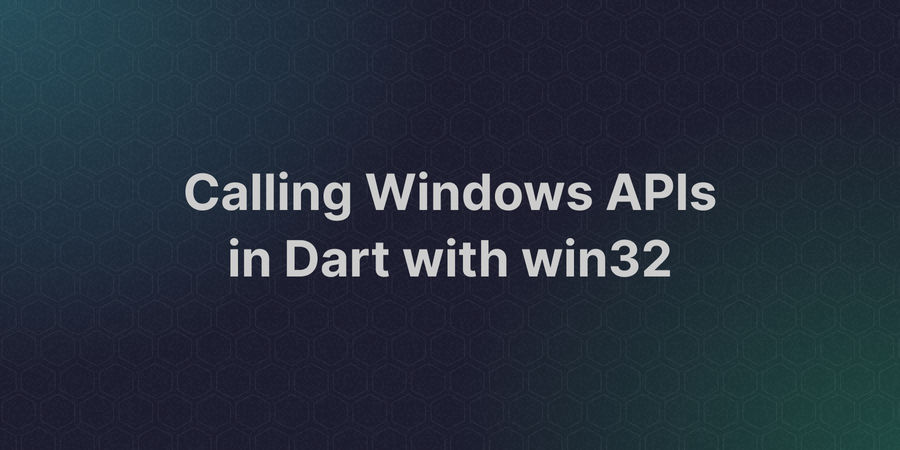

Calling Windows APIs in Dart with win32
Introduction
As Dart expands its reach beyond web and mobile development, interacting with native Windows APIs unlocks a world of possibilities. The win32 package serves as a bridge to the powerful features of the Windows operating system, allowing Dart developers to harness these capabilities directly in their applications.
In this blog post, we'll explore how to use the win32 package to call Windows APIs in Dart, enabling you to create powerful Windows applications with ease.
Here's what we'll cover:
What is win32?
win32 is a Dart package that wraps some of the most common Win32 API calls using FFI to make them accessible to Dart code without needing a C compiler or the Windows SDK.
The package simplifies the process of writing Dart code that can access Windows hardware and system services by providing easy-to-use bindings for traditional Win32 and COM (Component Object Model) API calls.
Whether you're looking to interact with hardware, access system services, or build sophisticated desktop applications, win32 has you covered.
Key Features
- Direct Windows API Access: Invoke Windows API functions directly from Dart without the need for a C compiler or additional setup.
- COM Support: Easily interact with COM libraries and components for advanced Windows functionalities.
- Extensive API Coverage: Access a broad range of Windows APIs, including system services, hardware, and registry.
- Seamless Integration: Effortlessly integrate with existing Windows libraries and services, enabling smooth interoperability.
- Cross-Platform Development: Develop cross-platform packages with specific implementations tailored for Windows environments.
- Developer-Friendly: Simplifies the complexity of Win32 API calls into easy-to-use Dart functions, enhancing developer productivity.
Getting Started
Let's dive into how you can get started with the win32 package and see it in action.
Add the ffi and win32 packages to your project with:
dart pub add ffi win32
Interacting with Windows APIs
Let's explore how you can interact with thee Windows APIs using the win32 package.
Displaying a Message Box
Let's start with a simple example that displays a message box using the MessageBox function from the Windows API.
import 'package:ffi/ffi.dart';
import 'package:win32/win32.dart';
void main() {
final lpCaption = 'Dart MessageBox Demo'.toNativeUtf16();
final lpText = '''
This is not really an error, but we are pretending for the sake of this demo.
Resource error.
Do you want to try again?
'''
.toNativeUtf16();
final result = MessageBox(
NULL,
lpText,
lpCaption,
MB_ICONWARNING | // Warning icon
MB_CANCELTRYCONTINUE | // Action button
MB_DEFBUTTON2, // Second button is the default
);
free(lpText);
free(lpCaption);
switch (result) {
case IDCANCEL:
print('Cancel pressed');
case IDTRYAGAIN:
print('Try Again pressed');
case IDCONTINUE:
print('Continue pressed');
}
}
Retrieving the System Memory
Next, let's retrieve the total amount of physical memory installed on the system using the GetPhysicallyInstalledSystemMemory function.
import 'dart:ffi';
import 'package:ffi/ffi.dart';
import 'package:win32/win32.dart';
void main() {
final memoryInKB = calloc<ULONGLONG>();
try {
final result = GetPhysicallyInstalledSystemMemory(memoryInKB);
if (result != 0) {
final memoryInMB = memoryInKB.value ~/ 1024;
print('System memory: $memoryInMB MB');
} else {
print('Failed to retrieve system memory.');
}
} finally {
free(memoryInKB);
}
}
Creating a Classic Win32 Window
Finally, let's create a classic Win32 window. First, we'll define the window procedure that will handle messages sent to the window.
import 'dart:ffi';
import 'package:ffi/ffi.dart';
import 'package:win32/win32.dart';
int mainWindowProc(int hWnd, int uMsg, int wParam, int lParam) {
switch (uMsg) {
case WM_DESTROY:
PostQuitMessage(0);
return 0;
case WM_PAINT:
final ps = calloc<PAINTSTRUCT>();
final hdc = BeginPaint(hWnd, ps);
final rect = calloc<RECT>();
final msg = 'Hello, Dart!'.toNativeUtf16();
GetClientRect(hWnd, rect);
DrawText(
hdc,
msg,
-1,
rect,
DT_CENTER |
DT_VCENTER |
DT_SINGLELINE,
);
EndPaint(hWnd, ps);
// Clean up
free(ps);
free(rect);
free(msg);
return 0;
}
return DefWindowProc(hWnd, uMsg, wParam, lParam);
}
Next, we'll define the winMain entry point, which creates the window and runs
the message loop.
// ...
void winMain(int hInstance, List<String> args, int nShowCmd) {
final className = 'Sample Window Class'.toNativeUtf16();
final lpfnWndProc = NativeCallable<WNDPROC>.isolateLocal(
mainWindowProc,
exceptionalReturn: 0,
);
final wc = calloc<WNDCLASS>();
wc.ref
..style = CS_HREDRAW | CS_VREDRAW
..lpfnWndProc = lpfnWndProc.nativeFunction
..hInstance = hInstance
..lpszClassName = className
..hCursor = LoadCursor(NULL, IDC_ARROW)
..hbrBackground = GetStockObject(WHITE_BRUSH);
RegisterClass(wc);
// Create the window.
final windowCaption = 'Dart Native Win32 window'.toNativeUtf16();
final hWnd = CreateWindowEx(
0, // Optional window styles.
className, // Window class
windowCaption, // Window caption
WS_OVERLAPPEDWINDOW, // Window style
// Size and position
CW_USEDEFAULT,
CW_USEDEFAULT,
CW_USEDEFAULT,
CW_USEDEFAULT,
NULL, // Parent window
NULL, // Menu
hInstance, // Instance handle
nullptr, // Additional application data
);
free(windowCaption);
free(className);
ShowWindow(hWnd, nShowCmd);
UpdateWindow(hWnd);
// Run the message loop.
final msg = calloc<MSG>();
while (GetMessage(msg, NULL, 0, 0) != 0) {
TranslateMessage(msg);
DispatchMessage(msg);
}
// Clean up
free(msg);
free(wc);
lpfnWndProc.close();
}
Finally, we'll define the main function to initialize the application and call
the winMain function. The win32 package provides the initApp helper
function, which sets up the WinMain function with all the necessary information,
including the entry point and command line arguments, simplifying the process
for you.
// ...
void main() => initApp(winMain);
Conclusion
The win32 package is a powerful tool for Dart developers aiming to leverage the full capabilities of the Windows operating system. By bridging the gap between Dart and the extensive Windows APIs, win32 enables you to create feature-rich applications with ease.
Whether you're displaying simple message boxes, querying system information, or creating complex graphical interfaces, the win32 package unlocks new possibilities for your Dart projects. Start exploring today and discover what you can build with Dart and Windows APIs!
For more detailed information, check out our documentation.